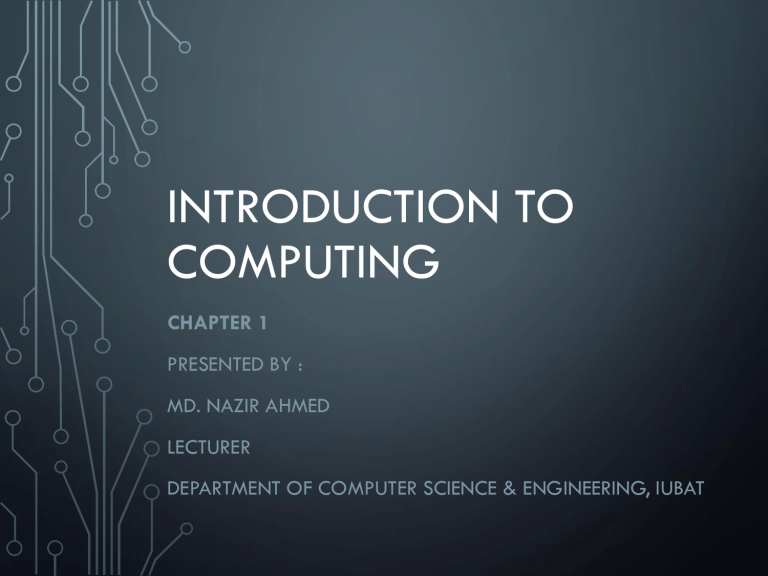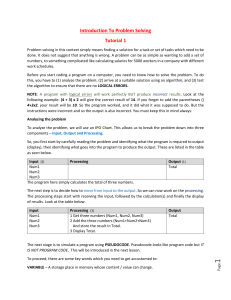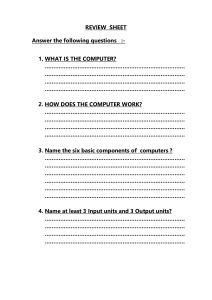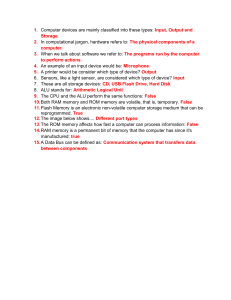
INTRODUCTION TO
COMPUTING
CHAPTER 1
PRESENTED BY :
MD. NAZIR AHMED
LECTURER
DEPARTMENT OF COMPUTER SCIENCE & ENGINEERING, IUBAT
INTRODUCTION
•
Components of Computer
CPU
Input Devices
Output Devices
Main Memory
• Hardware and Software
• Algorithm and Flowchart
• Pseudocode
COMPONENTS OF COMPUTER
• Computer
is used to perform various computations
involving arithmetic and logical operations.
CPU
Input
Device(s)
Output
Device(s)
Main Memory
Fig. 1.1 Components of Computer
CENTRAL PROCESSING UNIT
• All processing activities take place.
• Very Large Scale Integrated (VLSI) circuit.
• Consist of ALU, CU and Registers.
• ALU execute arithmetic and logical operations.
• CU is known as Brain of Computer.
• Register holds data or instructions.
ALU
CU
Fig. 1.2 Layout of a model CPU
Special Purpose
Register
Address Bus
Data Bus
General Purpose Register
Internal Bus
.
Control Bus
LAYOUT OF A MODEL CPU
INPUT DEVICES
• Through input devices users input data and instructions to
the computer.
• Basically information are transmitted to CPU/memory.
• Examples: keyboard, mouse, scanners, readers etc.
OUTPUT DEVICES
• Output devices are used to display the output.
• Examples- Monitor, Printer, Speaker, Plotters etc.
***NB- Input and output devices are known as peripheral
devices.
MEMORY
• Memory is used to store data.
• Access speeds and volatility.
Memory
Primary Memory
RAM
Secondary Memory
ROM
DIFFERENCE BETWEEN RAM & ROM
RAM
1.
Random Access Memory
ROM
1. Read Only Memory
2. Permits read & write operation
2. Permits read operation
3. Volatile memory
3. Non- volatile memory
4. High speed
4. Comparatively low speed
5. CPU can access data stored on RAM
directly
5. Data to be copied from ROM to RAM
so that CPU can access its data.
HARDWARE AND SOFTWARE
• Hardware is the physical components of a computer, such
as the motherboard, processor, memory, storage drives,
and other devices.
• Software is a set of instructions, data, or programs used
to operate a computer and execute specific tasks.
TYPES OF SOFTWARE
• System Software
• Operating System, loader, linker and translator
• Application Software
• Word processing software, image editing, spread sheet
packages, database software and accounting software.
ART OF PROGRAMMING THROUGH
ALGORITHMS AND FLOWCHARTS
ALGORITHM
• An algorithm is a finite set of unambiguous instructions
which, when executed, performs a task correctly.
EXAMPLE 1
• Develop an algorithm to find the average of three
numbers taken as input from the user.
Step 0 START
Step 1 INPUT first number into variable A
Step 2 INPUT second number into variable B
Step 3 INPUT third number into variable C
Step 4 COMPUTE SUM = A + B + C
Step 5 COMPUTE AVG = SUM / 3
Step 6 DISPLAY AVG
Step 7 END
PSEUDOCODE
• Pseudocode are a means to represent an algorithm in a
coded from.
Pseudocode Average
{
Declare variable num1,num2,num3,average
scan num1,num2,num3
average=(num1+num2+num3)/3
print “Average is: “,average
}
FLOWCHART
• A flowchart is a type of diagram that represents a
workflow or process.
• Notation used in flowchartName
Start/End
Input / Output
Process
Decision box
Connector
Off-page connector
Arrowed Line
Symbol
FLOWCHART EXAMPLE
• Flowchart for average of three numbersStart
Input
num1,num2,num3
Average=(num1+num2+num3)
Print Average
End






